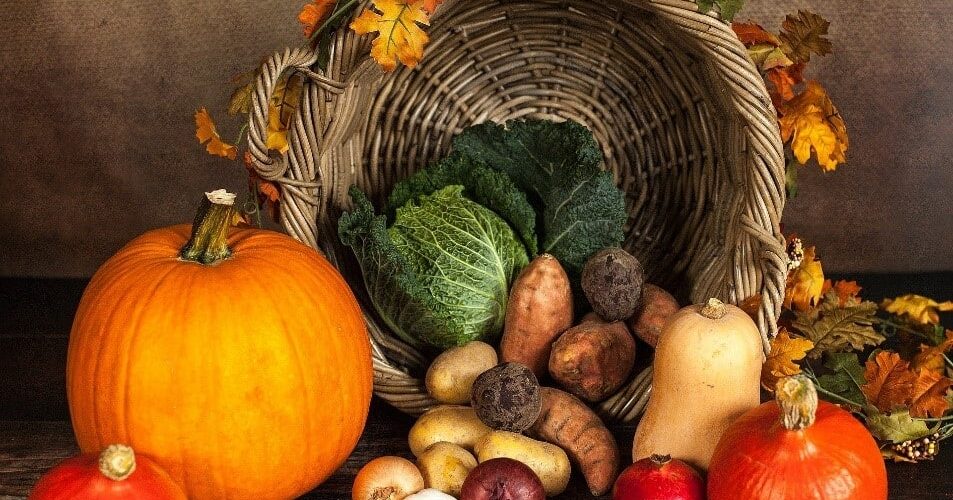Gardening in the UK in October
Harvest Festival
October is traditionally the month of harvest festival, the celebration of and thanksgiving for the success of the crops that have been grown during the year. It’s the nearest equivalent we have in the UK to Thanksgiving in the USA but doesn’t usually involve families getting together and it isn’t a public holiday. It has its origins in pagan times, but it’s now usually celebrated in schools and churches. People will take food (not necessarily crops these days) into church or school and this is distributed within the community. Churches very often hold harvest suppers which used to be attended by people who had worked on the harvest, but nowadays any church parishioners can take part in them.
October crops
Crops that can be harvested in October include apples, onions, carrots, beetroot and pumpkins. The last of the tomatoes should be picked this month, before the first frosts.
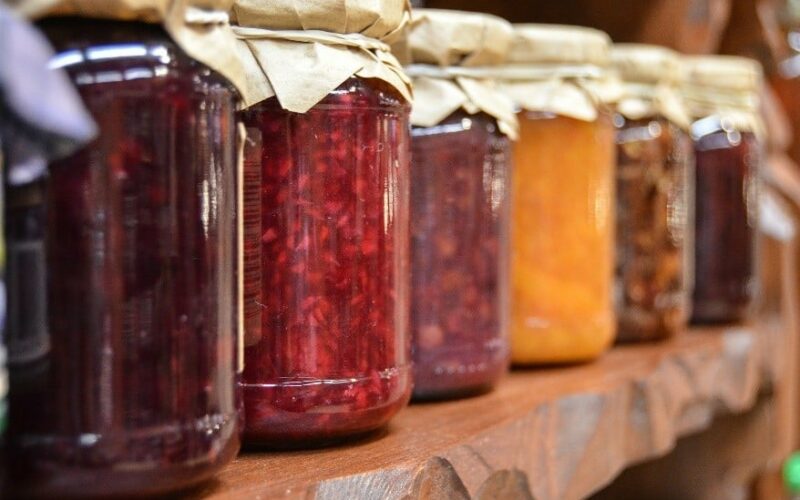
Many of these crops can be stored or preserved in the form of jams and chutneys or by bottling, especially if there is a glut. Some crops, such as potatoes, beetroot, parsnips, carrots, and apples, can be stored in a cool, dry place for up to six months. Others, such as beans, blackberries, apples, raspberries, and gooseberries can be frozen. It’s also possible to dry apples, chillis, and mushrooms, and tomatoes can be dried and then preserved in oil. which can be flavoured with herbs. I’ve just used up a glut of tomatoes by making tomato juice, which is very simple and very delicious. Just boil tomatoes and celery together in water to cover, liquidise and sieve – couldn’t be easier. There’s nothing more satisfying than seeing the fruits of your labours ready to be stored away for the winter as a memory of the summer past.
What to do in the Garden

Leaf Mould
Much of the work from September continues into this month. However, there’s definitely a chill in the air and the trees are starting to change colour and drop their leaves. This means that quite a lot of time is spent raking them up, especially when they are on the lawn, but the upside is that there is plenty of material for making leaf mould – a great soil conditioner that is completely free and worth all the hard work involved in gathering it. Leaves take longer to decompose than, for instance, grass clippings, but, 6-12 months later you should have some wonderful, crumbly material to dig into your soil. The process can be speeded up by running over the leaves with a lawnmower, as smaller pieces will obviously decompose more quickly. Moreover, mowing mixes in grass clippings which act as an accelerator.

Protecting Plants
We often have the first frosts in October, which means moving anything tender indoors, either to the greenhouse or conservatory. If you have a greenhouse, this is a good time to clear it out and give everything a good clean. The RHS website offers advice on cleaning greenhouses, gutters and water butts.
Once everything has been cleaned, the greenhouse can be insulated for the winter before placing the plants back again. The Grow Veg website offers advice on cheap and cheerful ways to insulate the greenhouse and protect tender plants by using materials such as bubble wrap, plastic bottles, and polystyrene:
What to Plant in October
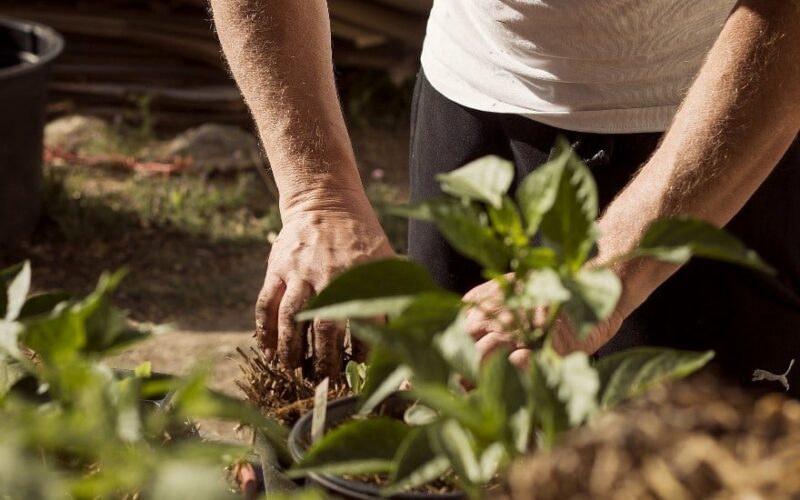
What to Plant in October
October is a good time to plant hardy herbaceous perennials, as the soil is still warm but moister than it was during the summer. It is possible to plant bare-root perennials straight into the soil if they are big enough, but smaller roots should be potted up and grown on in a sheltered part of the garden or in a cold frame.
The RHS website contains information about planting and spacing perennials.
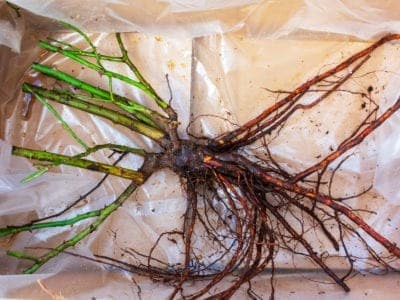
Bare root rose plant
October is also an ideal month for moving and planting shrubs, trees, and climbers. Bare root plants become available to order towards the end of the month and are much cheaper to buy than containerised plants. They also establish better. Now is a good time to prepare the soil for them before they arrive.
Bulbs, corms, and tubers can still be planted, and in the vegetable garden or allotment garlic, overwintering onion sets such as Radar, Electric and Snowball can be planted. Spring cabbages sown last month can usually be planted out this month. It’s also a good time to plant rhubarb crowns.
Pruning

Virginia Creeper (parthenocissus quinquefolia)
Many deciduous garden trees and shrubs can be pruned in October during their dormant period. These include crab apples, walnut trees and sorbus (mountain ash). Boston ivy and Virginia Creeper respond well to being cut hardback any time between now and December, but obviously, you will want to wait until after the leaves have turned colour and then dropped.
Pruning in October includes removing heavy branches from plants that can suffer from wind-rock during Autumn storms. These include tall roses and buddleia, especially if these are crowding out other plants. Deadheading of flowers such as dahlias can continue, in order to encourage the last of the blooms. Hardy perennials such as geraniums can be cut right back to stop them from sprawling, but some perennials with seed heads can be left to provide food for the birds during winter.
Sowing Sweet Peas
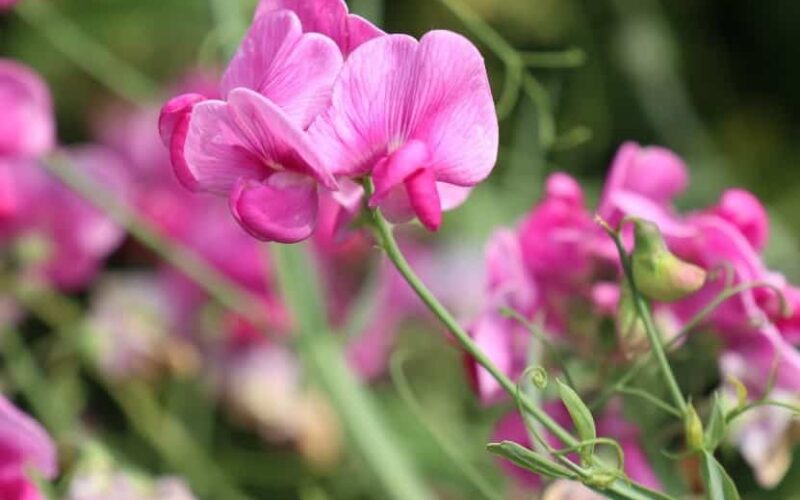
Sweet pea (lathyrus odoratus)
Sweet peas can be sown in the Autumn in most parts of the UK, which will give them a head start for next year, although seeds sown in the Spring will usually catch up eventually. Near where we live in Lincolnshire is Easton Walled Gardens, which is famous for its sweet peas and has open days each year so that people can go and see them. According to their website “By sowing in the Autumn instead of the Spring you give the plant 6 months of extra growth. By next summer they are able to sustain bigger, earlier flowers on strong stems”. They do have to be cared for over winter, so keeping them in a greenhouse is a good idea, but they don’t need lots of warmth. And, if they don’t germinate for whatever reason, you have another chance in the Spring!
The clocks go back

At the end of the month, the clocks go back one hour in the UK. Although this means an extra hour in bed (which you only really notice on the first day!) it means darker evenings and it feels like the onset of winter. So, unless you’re an early riser (which I’m not!), the amount of time available for pottering about in the garden and catching up with tasks diminishes. People who go out to work have little daylight at the end of the day to accomplish anything in the garden at all. There are advantages and disadvantages to the Daylight Savings Time system, and these have been debated since its introduction in the UK during World War 1.
But in a way, it’s quite good to have a rest from the garden and to stand back and think about it for a while. To quote Monty Don in October’s issue of “Gardeners’ World”
“…I always feel that October is the time to take stock in the garden. Now is the time to consider the failures and successes of the past garden year, as well as to plan and prepare for the next, not on a soupy January morning still lit by the waning lights of Christmas. September is misty-eyed and with a lovely fragility that deters any harsher scrutiny, but comes October, you have to be coldly realistic and look your garden in the eye”.

About the Author
Caroline Bowman has been hooked on gardening ever since she grew some thyme from seed and planted it in a window box when she lived in a flat in London. Fifty years later she is still hooked on gardening, but now she lives in Lincolnshire in England where they have quite a big suburban garden as well as an allotment, where they grow fruit and vegetables. Caroline loves flowering plants, in particular herbaceous perennials and she likes finding out about the more unusual varieties that will do well in the English climate and soil.
More from Gardenize
Images published on the Gardenize website belong to Gardenize AB and may not be used without permission.

